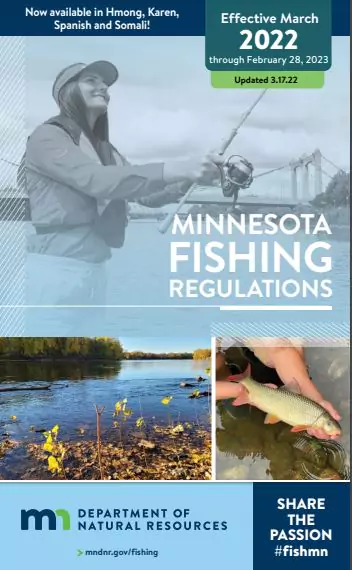‘Fishing Regulations Minnesota’ PDF Quick download link is given at the bottom of this article. You can see the PDF demo, size of the PDF, page numbers, and direct download Free PDF of ‘MN Fishing Regulations’ using the download button.
Minnesota Fishing Regulations Book PDF Free Download

MN Fishing Regulations
LAKE SUPERIOR AND ITS TRIBUTARIES
The following regulations clarify the fishing seasons and limits for Lake Superior and the streams and rivers flowing into it.
While fishing Minnesota waters, anglers must follow Minnesota regulations.
Licensing
Anyone fishing on the Minnesota waters of Lake Superior must possess a Minnesota angling license and a Minnesota trout/salmon stamp validation except as listed on page 18.
You need a Wisconsin fishing license to fish on Wisconsin waters of Lake Superior but you may fish the St. Louis River Estuary with a Minnesota fishing license.
Location
• There are two sets of fishing regulations for Lake Superior and its tributaries based on whether you are above or below a posted boundary, which corresponds to areas accessible to migratory fish.
A list of boundary locations on tributaries can be found on the DNR website or by contacting an Area Fisheries Office along the North Shore.
• Some tributary streams have special regulations. Additionally, some streams have sanctuary areas closed to fishing, including the French, Knife, Lester, Devil Track and Kadunce rivers, and Gauthier Creek. (See Experimental and Special Regulations, page 52-55.)
• Angling from boats is closed October 3 – November 30 on the portion of Lake Superior from the outermost portion of the north arm of the Duluth ship channel to the mouth of Chester Creek.
Hours
Angling hours on Lake Superior tributaries below the posted boundaries are from one hour before sunrise to one hour after sunset.
Exceptions are the St. Louis River Estuary (St. Louis and Carlton counties) and the Pigeon River (Cook County).
Methods
• Anglers are restricted to a single hook or fly only—no treble hooks—on Lake Superior tributary streams and rivers below the posted boundaries.
Exceptions are the St. Louis River (St. Louis and Carlton counties) and the Pigeon River (Cook County).
• No more than two lines may be used on Lake Superior, except only one line may be used within 100 yards of the mouth of any flowing stream.
• On Lake Superior tributaries below the posted boundaries, a fish that is hooked in any part of the body, except the mouth, must be immediately returned to the water.
Possession and Transportation
• Unclipped steelhead (rainbow trout) must be immediately released on Lake Superior and its
tributaries.
A clipped adipose fin, used to identify stocked trout, must show a healed scar (see diagram right).
Marking, tagging, or fin clipping fish and then releasing them without a DNR permit is unlawful.
• While fishing or while on the water, trout, salmon, muskellunge, and catfish must be
transported with head and tails intact.
• While transporting fish on land, 1) rainbow, brown and brook trout, and splake must be transported with head and tail intact; and 2) salmon, lake trout, and walleye may be filleted but must retain a 1-inch square patch of skin with scales.
See pages 33-34 for additional general information on transporting fish.
• Rough fish or other species not named in the Lake Superior section are subject to inland regulations.
Taking of Smelt
• Smelt may be taken night or day. Artificial lights may not be used to lure or attract smelt.
There is no limit on smelt, and smelt from Lake Superior may be bought or sold; however, live smelt may not be possessed or transported.
• Dip nets may be used for taking smelt.
Minnow seines not more than 25 feet long or 4 feet deep may be used to take smelt in the St. Louis River and in Lake Superior when more than 100 feet from the mouth of any stream.
• Taking of smelt at any time is prohibited in the following Lake Superior Tributaries: French River, Sucker River, Little Sucker River (St. Louis County); Silver Creek, Encampment Creek, and Crow Creek (Lake County).
Taking Smelt and Cisco (Tullibee), and Trout Eggs, for Bait.
• Anglers may take cisco (tullibee) or smelt from Lake Superior or its tributaries below the posted boundaries to use as bait only on Lake Superior.
• To use cisco (tullibee) or smelt is taken from Lake Superior or its tributaries as bait on other water bodies, the fish must be preserved under a DNR-issued bait preservation permit.
Permit applications are available from the DNR, 500 Lafayette, St. Paul, MN 55155-4026. Freezing is not a preservation method.
• No other fish species from Lake Superior or its tributaries below the posted boundaries, or the St. Louis River downstream of the Fond du Lac dam, may be used as bait except trout eggs (see next bullet).
• Eggs of trout harvested from Lake Superior or its tributaries below the posted boundaries may be used as bait (spawn bags).
Spawn bags from Lake Superior trout may only be used on Lake Superior and its tributaries below the posted boundaries, and no other waters in the state.
• Spawn bags can be bought or sold only if they are made from either 1) fish eggs from a licensed aquaculture facility, or 2) fish eggs are taken from a source outside Minnesota that has been certified disease free and are preserved and labelled under a Minnesota bait preservation permit.
These spawn bags may only be used in Lake Superior and tributaries below posted boundaries.
| Author | – |
| Language | English |
| No. of Pages | 93 |
| PDF Size | 10 MB |
| Category | General |
| Source/Credits | files.dnr.state.mn.us |
Minnesota Fishing Regulations Book PDF Free Download
